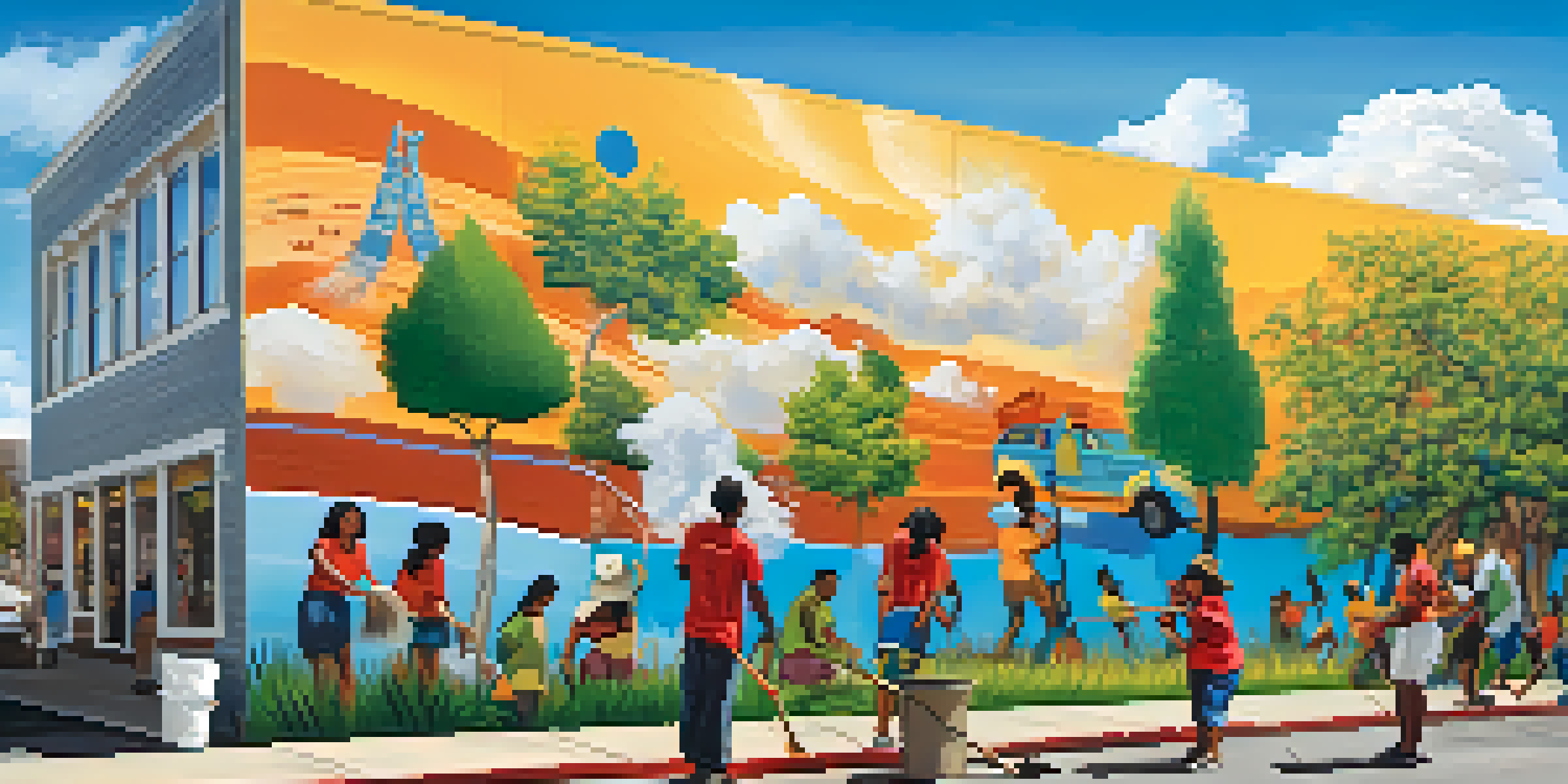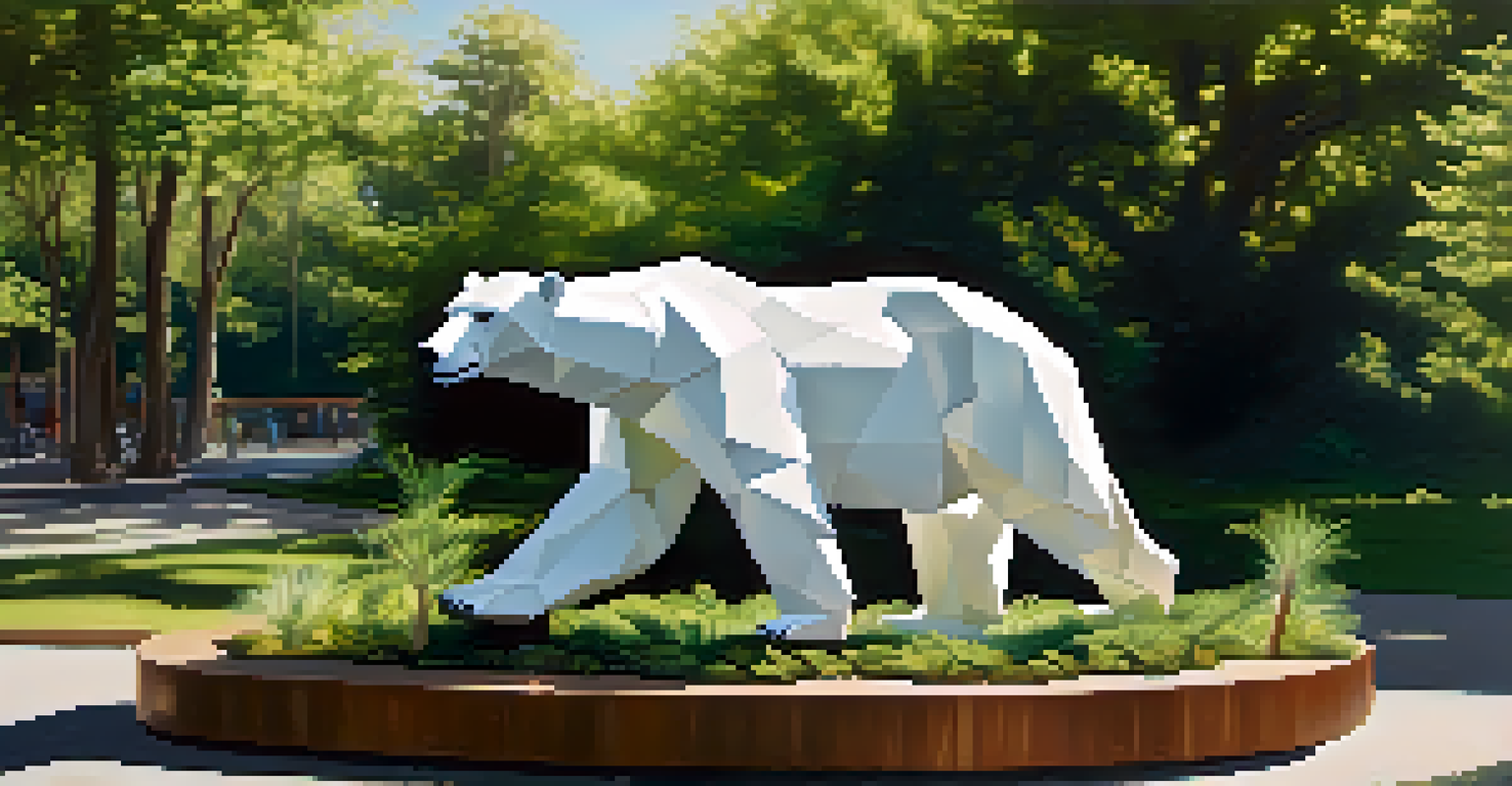The Role of Public Art in Climate Change Awareness Campaigns

What is Public Art and Its Importance?
Public art encompasses artworks created for public spaces, often aiming to engage communities and provoke thought. This can include murals, sculptures, installations, and performances that are accessible to everyone. The beauty of public art lies in its ability to communicate messages without the need for words, making it a universal language.
Art is not a mirror to hold up to society, but a hammer with which to shape it.
In the context of climate change, public art serves as a powerful platform to raise awareness and inspire action. By integrating environmental themes into art, artists can connect with people on an emotional level, creating a sense of urgency around the climate crisis. This emotional connection is crucial, as it encourages individuals to reflect on their own impact on the planet.
Moreover, public art often draws attention to local environmental issues that may otherwise go unnoticed. For instance, a mural depicting rising sea levels can serve as a stark reminder of the realities faced by coastal communities. Through this lens, public art not only beautifies spaces but also transforms them into catalysts for change.
How Public Art Engages Communities
One of the most remarkable aspects of public art is its ability to bring communities together. Art installations can serve as focal points for gatherings, discussions, and workshops, fostering a collaborative spirit among residents. When people come together to create or appreciate art, they often find common ground in their shared concerns about the environment.

Public art projects often involve community input, allowing residents to express their perspectives on climate change. This engagement not only empowers individuals but also helps to surface diverse viewpoints and solutions. By giving the community a voice, public art can cultivate a sense of ownership and responsibility toward local environmental issues.
Public Art Inspires Climate Action
Public art engages communities and raises awareness about climate change by provoking thought and fostering emotional connections.
Additionally, these art projects can spark dialogue about climate action, prompting individuals to take steps toward sustainability. Whether it's through organizing clean-up events inspired by a mural or participating in workshops, public art can act as a springboard for community-led climate initiatives.
The Emotional Impact of Art on Awareness
Art has a unique ability to evoke emotions, which is vital for raising awareness about climate change. When people see a powerful image or experience a thought-provoking installation, they may feel compelled to reflect on their relationship with the environment. This emotional reaction can lead to a deeper understanding of climate issues and a desire to take action.
Public art can transform a space and create a dialogue with the community about important issues.
For example, a haunting sculpture representing endangered species can serve as a wake-up call, urging viewers to consider the consequences of their actions. Such emotional triggers can transform apathy into empathy, motivating individuals to change their behaviors and advocate for the planet.
Moreover, art can help visualize abstract concepts like carbon emissions or climate data, making them more relatable. By turning complex scientific information into tangible experiences, public art can break down barriers to understanding and inspire a broader audience to engage with climate change.
Successful Examples of Climate-Focused Public Art
Numerous public art projects have successfully highlighted climate change and its effects. For instance, the 'Ice Watch' project involved placing large blocks of melting ice from Greenland in urban spaces, inviting viewers to witness the tangible effects of global warming. This installation not only captured attention but also sparked conversations about climate action in everyday settings.
Another notable example is the 'Sea Walls' project, which brings together artists to create murals that address ocean conservation. These vibrant artworks not only beautify coastal communities but also serve as reminders of our responsibility to protect marine ecosystems. Such initiatives illustrate how art can amplify environmental messages and encourage community engagement.
Art as a Community-Building Tool
Public art projects bring residents together, allowing them to express their views on environmental issues and promoting a sense of ownership.
These projects highlight the potential of public art to serve as a rallying cry for climate action. By merging creativity with advocacy, artists can inspire individuals and communities to take a stand against climate change and work collectively toward solutions.
Public Art as Educational Tools
Public art can also serve as an educational tool, bridging the gap between scientific information and public understanding. Through informative murals, installations, and performances, artists can convey complex climate data in a visually engaging manner. This accessibility is crucial for reaching broader audiences and fostering informed discussions about climate change.
For instance, murals that depict local flora and fauna at risk from climate change can educate the community about biodiversity loss. By showcasing the beauty of these species, artists can instill a sense of urgency and responsibility toward conservation efforts. Education through art can empower individuals to advocate for protective measures and sustainability initiatives.
Furthermore, public art projects can incorporate workshops and events that teach participants about climate science and advocacy strategies. By combining artistic expression with education, these initiatives can cultivate a more informed and proactive public, ultimately strengthening the movement against climate change.
Challenges Facing Public Art and Climate Campaigns
Despite its transformative potential, public art projects focused on climate change face several challenges. Funding is often a significant barrier, as artists and organizations may struggle to secure financial support for their initiatives. Without adequate resources, many impactful projects may never come to fruition, limiting the reach of climate awareness campaigns.
Additionally, public art can sometimes face pushback from local authorities or community members who may not prioritize environmental issues. This resistance can inhibit the creation of impactful works that address climate change. Engaging with stakeholders from the outset is essential to ensure that projects resonate with the community and gain necessary support.
Challenges in Public Art Projects
Despite its potential, public art initiatives face funding issues and community resistance, which can hinder their impact on climate advocacy.
Moreover, artists often grapple with the challenge of conveying urgency while remaining hopeful. Striking the right balance between alarming audiences about climate realities and inspiring them to take action can be difficult. However, when done effectively, public art can motivate individuals to be part of the solution rather than succumb to despair.
The Future of Public Art in Climate Advocacy
Looking ahead, the role of public art in climate change awareness will likely continue to evolve. As artists become increasingly aware of their influence, we can expect to see more creative and innovative projects that address pressing environmental issues. The integration of technology and interactive elements in public art could further engage audiences, making the experience more immersive.
Collaboration between artists, scientists, and activists can also pave the way for more impactful projects. By combining artistic vision with scientific expertise, public art can convey critical messages while remaining grounded in reality. This interdisciplinary approach can enhance the effectiveness of climate campaigns and amplify their reach.

Ultimately, public art holds the potential to inspire not just awareness but also action. By harnessing the creativity and passion of artists, communities can come together to combat climate change and envision a sustainable future. The journey is just beginning, and public art will undoubtedly play a pivotal role in shaping that path.